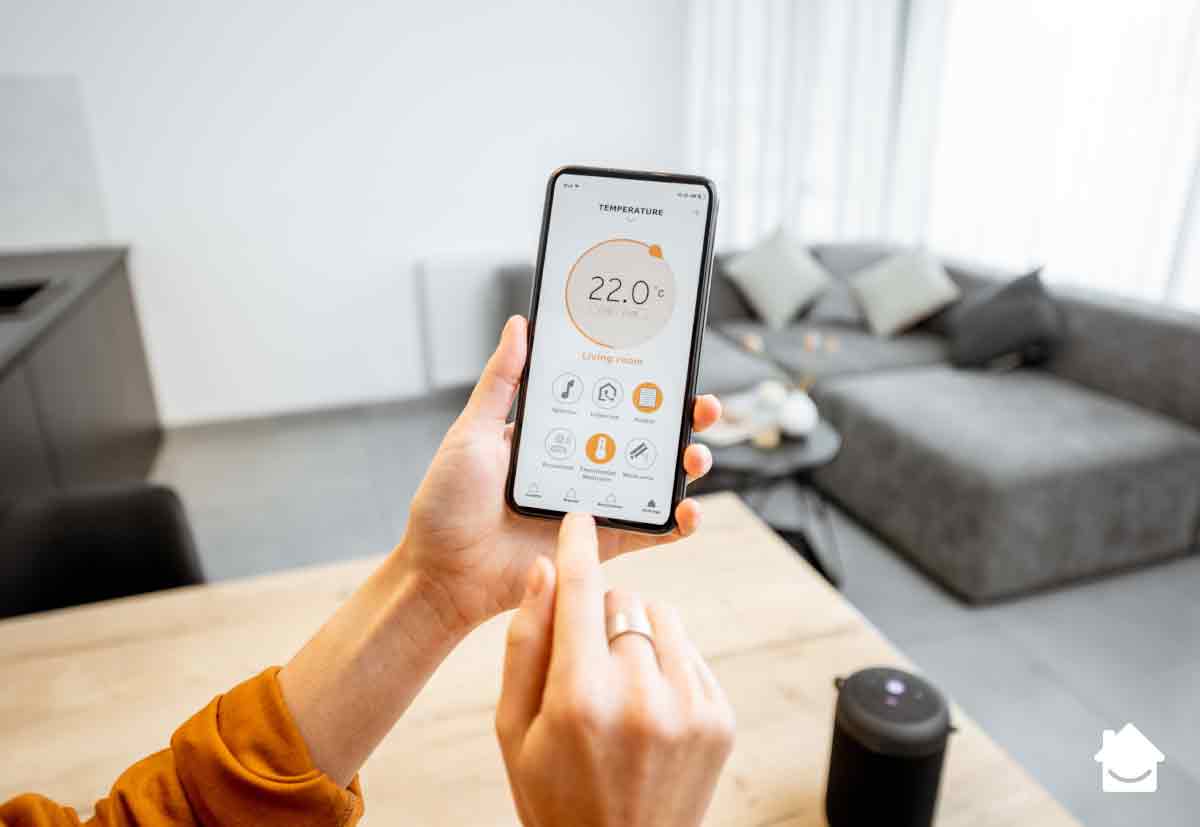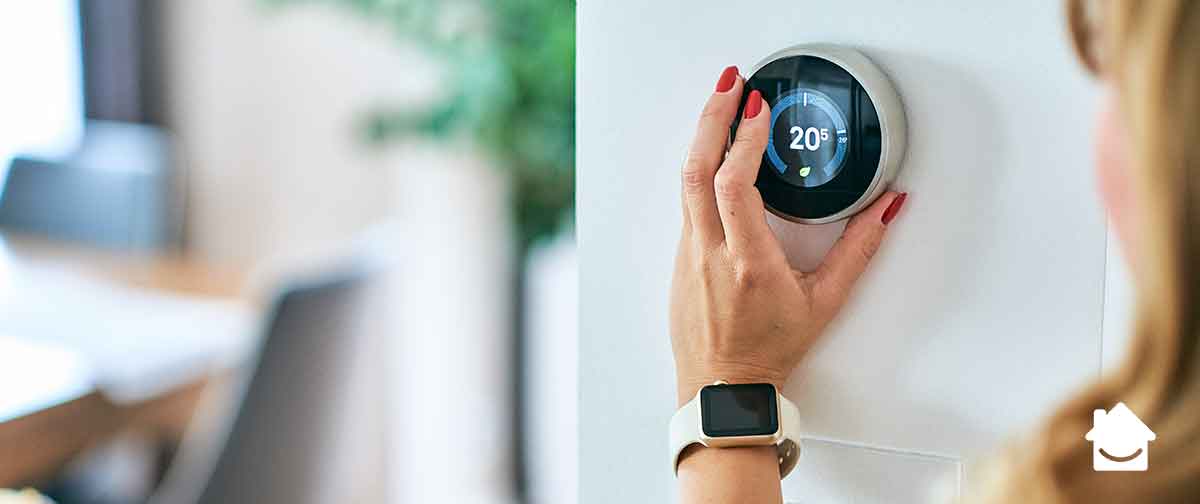Energy saving advice
What is a smart home?
29 Oct 2020 • 9 minutes


If you’re curious about smart homes, this guide will help you understand what a smart home is and how you can benefit without needing a technology degree. We’ll also talk about how smart devices work, what the different options are, and finally, how you can create your own smart home.
A smart home uses one or more internet-connected devices to let you control and see what’s going on in your home, whether you’re in another room – or another country.
All you need is a smartphone or tablet, a very reliable internet connection and some smart devices, and you can potentially automate tasks like feeding your cat and watering the plants every day, even if you’re on holiday. You could check on your new puppies while you’re at work, or even double-check that you’ve switched the heating off.
In a smart home, you may be able to control and adjust your:
…all at the touch of a button on an app, or even through a voice command.
Smart homes can also monitor their own activity and provide intelligent feedback on the data. For example, if you’re out, a smart home can monitor the temperature and heat or cool the room as soon as the temperature is out of its set range. You could even turn up the heating at home in the taxi back from the airport!
The technology in a smart home aims to make our lives easier. This could mean monitoring how many staple items you have, e.g. Toilet paper, and automatically ordering more from the online supermarket on your behalf, or a smart fridge making meal recommendations based on the ingredients in your fridge. In fact, as the ‘Internet of Things’ (IoT) grows, the potential is endless.
Another big benefit of smart homes is potentially cutting the cost of your utility bills, by always monitoring your heating, water and electricity use.
Smart homes can also protect the most vulnerable in our communities. Some smart devices can trigger an alert if an elderly person forgets to take their pills, falls over or stops following their normal routine.
In order for your home to become a ‘smart home’, you need a few smart devices. They connect to the internet and usually have a smartphone app allowing you to monitor the device remotely over Wi-Fi. Here are some popular smart devices:
The smart home devices you choose will depend on what you want to monitor and operate remotely. If you’re concerned about security, comfort, convenience or energy efficiency, then all of these can be enhanced through the use of a smart home device and a smart home system.
A smart home system is a central hub for your smart devices, allowing them to work together, sharing and automating actions according to your preferences. For example, if your smart thermostat detects a cold breeze in the home, it could check your smart windows are all closed tight for you.
Choosing the smart home ecosystem you wish to use will influence the smart devices you’re able to buy in the future. Here are three of the top options on the market:
There are many more systems and smart hubs on the market, including Apple HomeKit and Samsung SmartThings.
A smart home hub or ‘bridge’ serves as the control centre in your home and ties all your devices together all in one place.
A smart home hub, unlike a smart home system such as Amazon Alexa, works above that device to control it and others without having to worry about integrations. Different smart devices use different ‘protocols’ to talk to each other, and many smart home hubs can support multiple protocols, which means you do not have to stay loyal to one particular system or brand – handy! But we recommend you do some research to make sure you get the right hub for your needs.
For example, if you just want to focus on one particular aspect of your home, such as security, then you can buy a smart home hub that is dedicated purely to security.
If you buy a range of different smart devices (e.g. smart lightbulbs, thermostats, or locks) it’s not guaranteed they will all be able to speak to each other and become part of one of the ecosystems we mentioned earlier – Amazon Alexa, Google Assistant, etc.
Have no fear – this is where your smart home hub or bridge comes in. To ‘bridge’ your smart devices together, you will need to consult the guides specific to your device and to your smart home ecosystem.
It is worth noting, however, that not all smart devices will be able to bridge and this may restrict you when it comes to purchasing products to build your smart home.

Are you now wondering how to create a smart home? You don’t have to go all-out to begin with. You can start small by using your pick of a whole range of technologies. Here are just a few:
Control your TV through gestures/motions and voice activation (or simply access your Netflix!).
Smart lighting can regulate itself depending on daylight availability, timers, mood settings and when you enter rooms.
Whether you use Alexa, Google Assistant or any other smart speaker, you can add speaker systems that give you multi-room audio – e.g. letting you listen to the radio in the kitchen while your partner streams music in another room. You get brilliant sound quality and access to millions of songs at the tap of an app, or even with your voice.
With smart locks, doorbells, garage doors, cameras and motion detectors you can get quick access to your home without fumbling with keys – you can also let visitors in or deny access and keep your home safe from intruders.
Control and customise the temperature to ensure maximum comfort as well as energy efficiency (and potentially cheaper bills!). Read our Why choose a smart thermostat article to find out more.
This is where smart technology becomes a no-brainer. A smoke alarm that tells you there’s a fire is useful. One that alerts you to the fire via an app when you’re out of the house is more useful. If you have a second home or you travel a lot, this is for you.
You can get pet feeders and watering devices that can automatically care for pets like cats and plants if you’re away over the weekend.
From washing machines that start remotely and let you know when to call a professional to fix them, to fridges that track expiration dates, a smart kitchen can make life easier.
If you’re looking for complete peace of mind over plumbing issues, smart water leak alarm LeakBot detects water leaks and can organise a plumber to take care of any detected issues. Other smart monitoring devices can detect electrical surges and turn off appliances accordingly.

Build a smart home to suit your specific needs and you’ll benefit from:
If you’ve forgotten to turn off the lights, put the washing machine on or turn the heating down when you leave the house, with smart products, you can control them remotely and make sure your house is always under control at the touch of a button.
If you’re looking for other ways to cut down on your energy use and save money, see our energy saving tips for home and what to switch off at home when you go on holiday guides.
Smart devices are jam-packed with sophisticated technology, so prices do vary. Smart speakers are between £100-200, for example, and although all smart products will require an initial investment – if you use the device to its fullest potential, it may be well worth the initial investment.
For example, if you use a water leak detection system such as LeakBot and fix a water leak before it causes too much damage to your home, then it may pay for itself. This is similar for smart devices that save energy. It’s important to listen to the alerts and follow them promptly to get the most cost-effective benefit from the device.
If an elderly family member of yours is living independently but needs some support, smart devices can be excellent. For example, an Amazon Echo can help with alerts and reminders, while a smart hub can manage smoke and carbon monoxide detectors for peace of mind.
Some smart devices can help to monitor their health and safety or perhaps automate activities on their behalf. Some devices also have cameras, so loved ones can check in regularly for comfort and reassurance.
For those who are forgetful, having heating and lighting that’s automated can help to save energy and increase safety if they forget to turn things off.
Without a doubt, smart devices make it easy to get an instant response. For example, if you’re coming home in the dark with your hands full, then switching on the lights before you arrive or with voice activation can be a great help. Instead of turning on the radio searching for songs you like, you can just ask your Amazon Echo to play the music you love. A smart device is a great hands-free experience so you can multi-task and do more with your time.
Smart devices can improve access and security around the home, such as through motion sensors, smart locks, doorbells and smart windows and doors. However, there have been issues of smart homes being compromised through security breaches so always be mindful of how your personal data is used.
If you avoid gimmicks and choose smart devices that individually, practically make your life easier, with an eye on the bigger picture of how they all fit into a smart home ecosystem, we think a smart home can be well worth it.
Are you looking to elevate your smart home experience and get even more peace of mind? HomeServe’s range of comprehensive Home Cover options is here to protect your home’s essential systems.
Our help & advice articles cover Plumbing, Home heating, Electrical, Energy-saving and Home maintenance.